check engine AUDI Q5 2016 Owner's Manual
[x] Cancel search | Manufacturer: AUDI, Model Year: 2016, Model line: Q5, Model: AUDI Q5 2016Pages: 300, PDF Size: 75.02 MB
Page 217 of 300
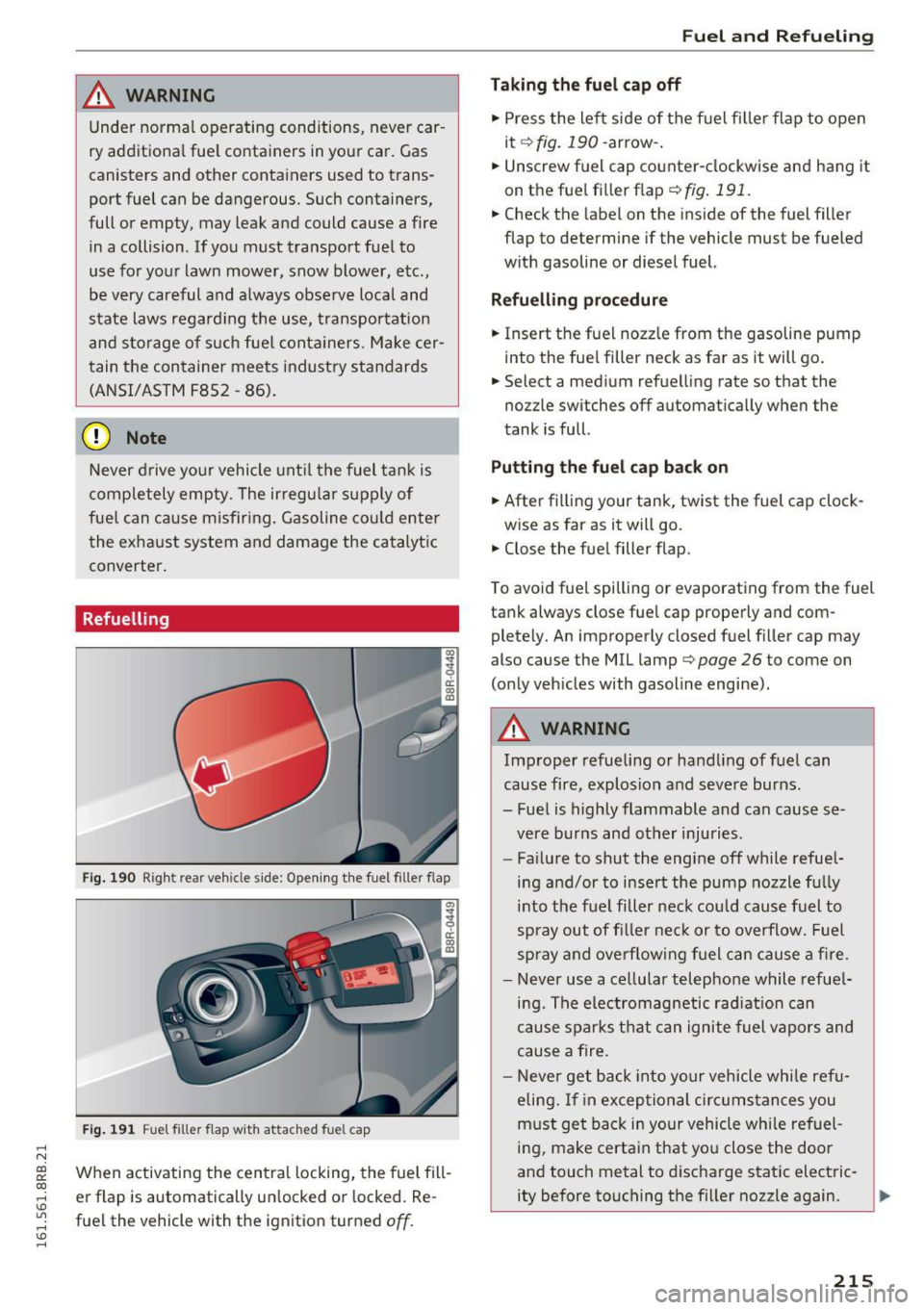
..... N
co ~ CX)
..... I.Cl U"I
..... I.Cl .....
,&_ WARNING
Under normal operating conditions, never car
ry additiona l fue l containers in your car. Gas
canisters and other containers used to trans
port fuel can be dangerous. Such containers,
full or empty, may leak and could cause a fire
in a collision. If you must transport fuel to
use for your lawn mower, snow blower, etc.,
be very careful and a lways observe local and
state laws regarding the use, transportation
and storage of such fue l conta iners. Make cer
tain the container meets industry standards
(ANSI/ASTM F852 -86) .
(D Note
Never d rive your vehicle unt il the fuel tank is
completely empty. The irregu lar supply of
fue l can cause misfiring. Gasoline cou ld enter
the exhaust system and damage the catalytic
converter.
Refuelling
Fig . 190 Righ t rear vehicle side: Opening the fuel fille r flap
Fig . 191 Fuel filler flap wit h attac hed fuel cap
When activating the central locking, the fuel fill
er flap is automatically unlocked or locked. Re
fuel the vehicle with the ignition turned
off .
Fue l an d Re fuelin g
Taking the fuel c ap off
.,. Press the left side of the f uel filler flap to open
it¢fig.190-arrow-.
.,. Unscrew fuel cap counter-clockwise and hang it
on the fuel filler flap¢
fig. 191 .
.,. Check the label on the inside of the fuel filler
flap to determine if the vehicle must be fueled
w ith gasoline or diesel fuel.
Refu ellin g pr ocedure
.,. Insert the fuel nozzle from the gasoline pump
into the fuel fill er neck as far as it will go.
.,. Select a medium refuelling rate so that the
nozzle switches off automatically when the
tank is full.
Pu tting th e fuel cap ba ck on
.,. After filling your tank, twist the fuel cap clock-
wise as far as it will go.
.,. Close the fuel filler flap.
T o avoid fuel spilling or evaporating from the fuel
tank always close fue l cap properly and com
pletely. An improperly closed fuel filler cap may
also cause the MIL lamp ¢
page 26 to come on
(only vehicles with gasoline engine).
A WARNING
-
Improper refueling or handling of fuel can
cause fire, explosion and severe burns . -
- Fuel is highly flammable and can cause se
vere burns and other injuries.
- Fa ilure to shut the engine off while refuel
ing and/or to insert the pump nozzle fully
into the fue l filler neck could cause fuel to
spray out of fi ller ne ck or to overflow. Fue l
spray and overflowing f uel can cause a fire.
- Never use a cellular telephone while refue l
ing. The electromagnetic rad iat ion can
cause sparks that can ignite fuel vapors and
cause a fire.
- Never get back into your vehicle while refu
eling. If in exceptional circumstances you
must get back in your vehicle whi le refuel
ing, make certa in that you close the door
and touch metal to discharge static electric-
ity before touching the filler nozzle again. ..,
215
Page 222 of 300
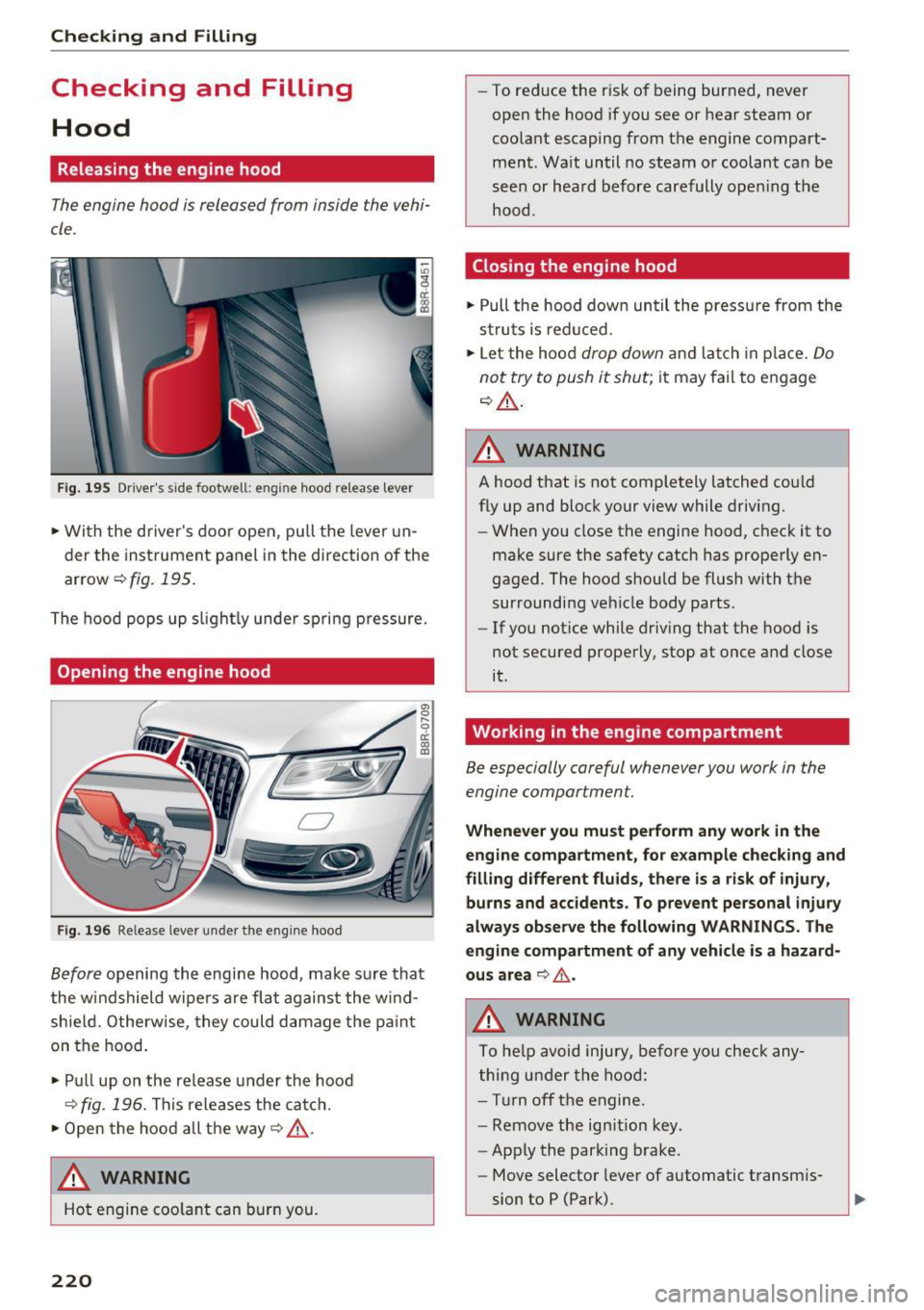
Checking and Filling
Checking and Filling Hood
Releasing the engine hood
The engine hood is released from inside the vehi
cle .
Fig. 195 Driver's side footwell : eng ine hood release lever
.. With the driver's door open, pull the lever un
der the instrument panel in the direction of the
arrow ¢
fig. 195.
The hood pops up slightly under spring pressure.
Opening the engine hood
CJ
Fig. 196 Release lever under t he e ngi ne hood
Before opening the engine hood, make sure that
the windshield wipers are flat against the w ind
shield. Otherwise, they could damage the paint
on the hood.
.,. Pull up on the release under the hood
¢
fig . 196. This releases the catch.
.,. Open the hood all the way ¢.&_ .
,& WARNING
Hot engine coo lant can burn you.
220
-To reduce the r isk of being burned, never
open the hood if you see or hear steam or
coo lant escaping from the engine compart
ment. Wait until no steam or coolant can be
seen or heard before carefully opening the
hood .
Closing the engine hood
.,. Pull the hood down until the pressu re from the
struts is reduced .
.. Let the hood
drop down and latch in place. Do
not try to push it shut;
it may fail to engage
~A -
A WARNING
A hood that is not completely latched could
fly up and block your view while driving.
- When you close the engine hood, check it to
make sure the safety catch has properly en
gaged . The hood should be flush with the
surrounding vehicle body parts .
- If you notice while driv ing that the hood is
not secured properly, stop at once and close
it .
Working in the engine compartment
Be especially careful whenever you work in the
engine compar tment.
-
Whenever you must perform any work in the
engine compartment , for example checking and
filling different fluids, there is a risk of injury,
burns and accidents. To prevent personal injury
always observe the following WARNINGS. The
engine compartment of any vehicle is a hazard
ous area ¢.&, .
A WARNING
To help avoid injury, before you check any
thing und er the hood:
- Turn off the engine.
- Remove the ign ition key .
- Apply the parking brake.
- Move selector lever of automatic transm is-
sion to P (Park).
-
Page 223 of 300
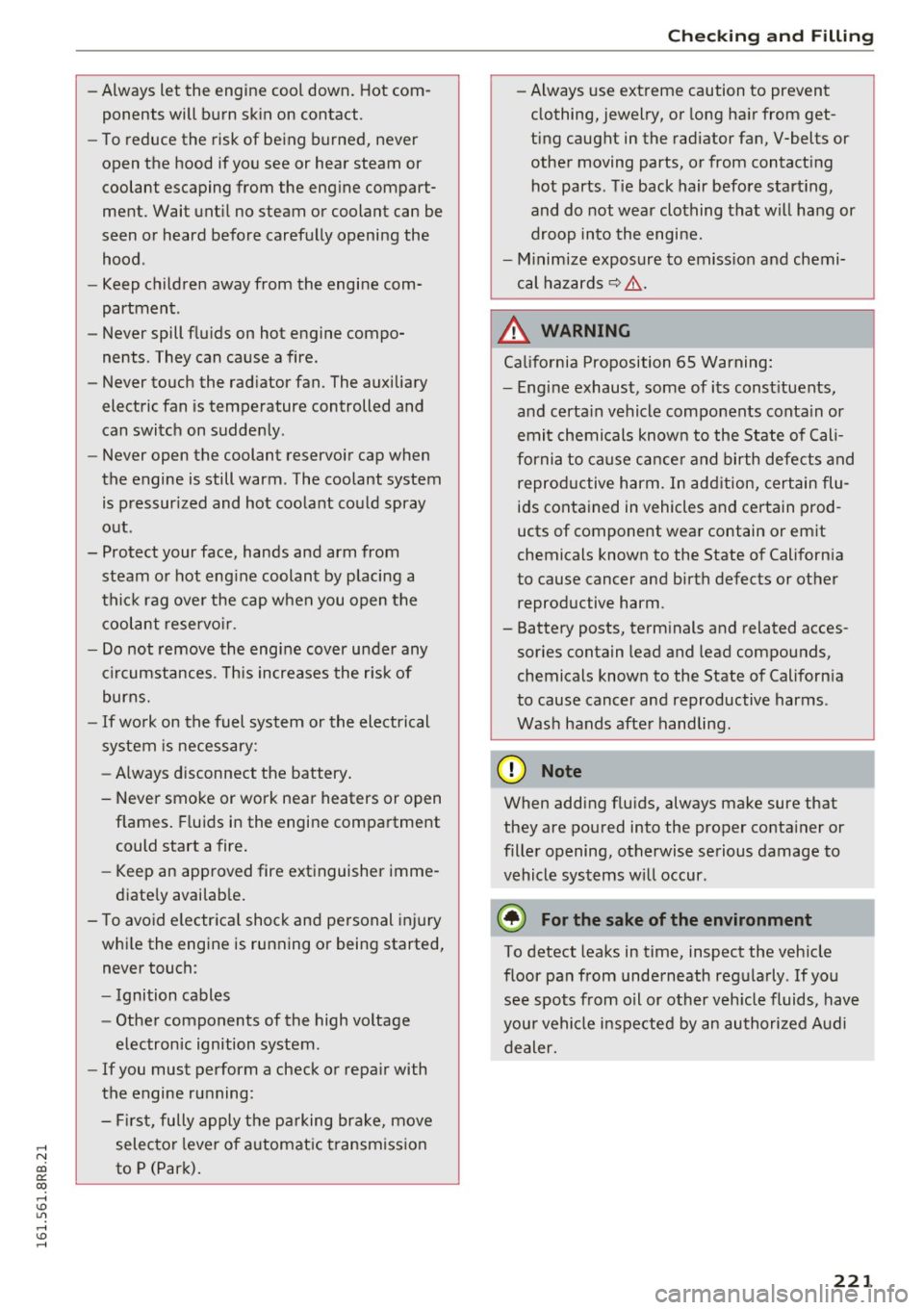
,....,
N
co
er::
co
,....,
ponents will burn skin on contact .
- To reduce the risk of being burned, never
open the hood if you see or hear steam or
coolant escaping from the engine compart
ment. Wait until no steam or coolant can be
seen or heard before carefully opening the
hood.
- Keep children away from the engine com
partment .
- Never spill fluids on hot engine compo
nents. They can cause a fire .
- Never touch the radiator fan. The auxiliary
electric fan is temperature controlled and
can switch on suddenly.
- Never open the coolant reservoir cap when
the engine is still warm. The coolant system
is pressurized and hot coolant could spray
out .
- Protect your face, hands and arm from
steam or hot engine coolant by placing a
thick rag over the cap when you open the
coolant reservoir .
- Do not remove the engine cover under any
circumstances. This increases the risk of
burns.
- If work on the fuel system or the electrical
system is necessary:
- Always disconnect the battery.
- Never smoke or work near heaters or open
flames. Fluids in the engine compartment
could start a fire.
- Keep an approved fire extinguisher imme
diately available.
- To avoid electrical shock and personal injury
while the engine is running or being started, never touch:
- Ignition cables
- Other components of the high voltage
electronic ignition system .
- If you must perform a check or repair with
the engine running:
- First, fully apply the parking brake, move
selector lever of automatic transmission
to P (Park).
Checking and Filling
-Always use extreme caution to prevent
clothing, jewelry, or long hair from get
ting caught in the radiator fan, V-belts or
other moving parts, or from contacting hot parts. Tie back hair before starting,
and do not wear clothing that will hang or
droop into the engine.
- Minimize exposure to emission and chemi
cal hazards
~ .&, .
A WARNING
California Proposition 65 Warning:
- Engine exhaust , some of its constituents,
and certain vehicle components contain or
emit chemicals known to the State of Cali
fornia to cause cancer and birth defects and
reproductive harm. In addition, certain flu
ids contained in vehicles and certain prod
ucts of component wear contain or emit
chemicals known to the State of California
to cause cancer and birth defects or other
reproductive harm.
- Battery posts, terminals and related acces
sories contain lead and lead compounds,
chemicals known to the State of California
to cause cancer and reproductive harms .
Wash hands after handling .
(I) Note
When adding fluids, always make sure that
they are poured into the proper container or
filler opening, otherwise serious damage to
vehicle systems will occur.
@) For the sake of the environment
To detect leaks in time, inspect the vehicle
floor pan from underneath regularly . If you
see spots from oil or other vehicle fluids, have
your vehicle inspected by an authorized Audi dealer.
221
Page 224 of 300
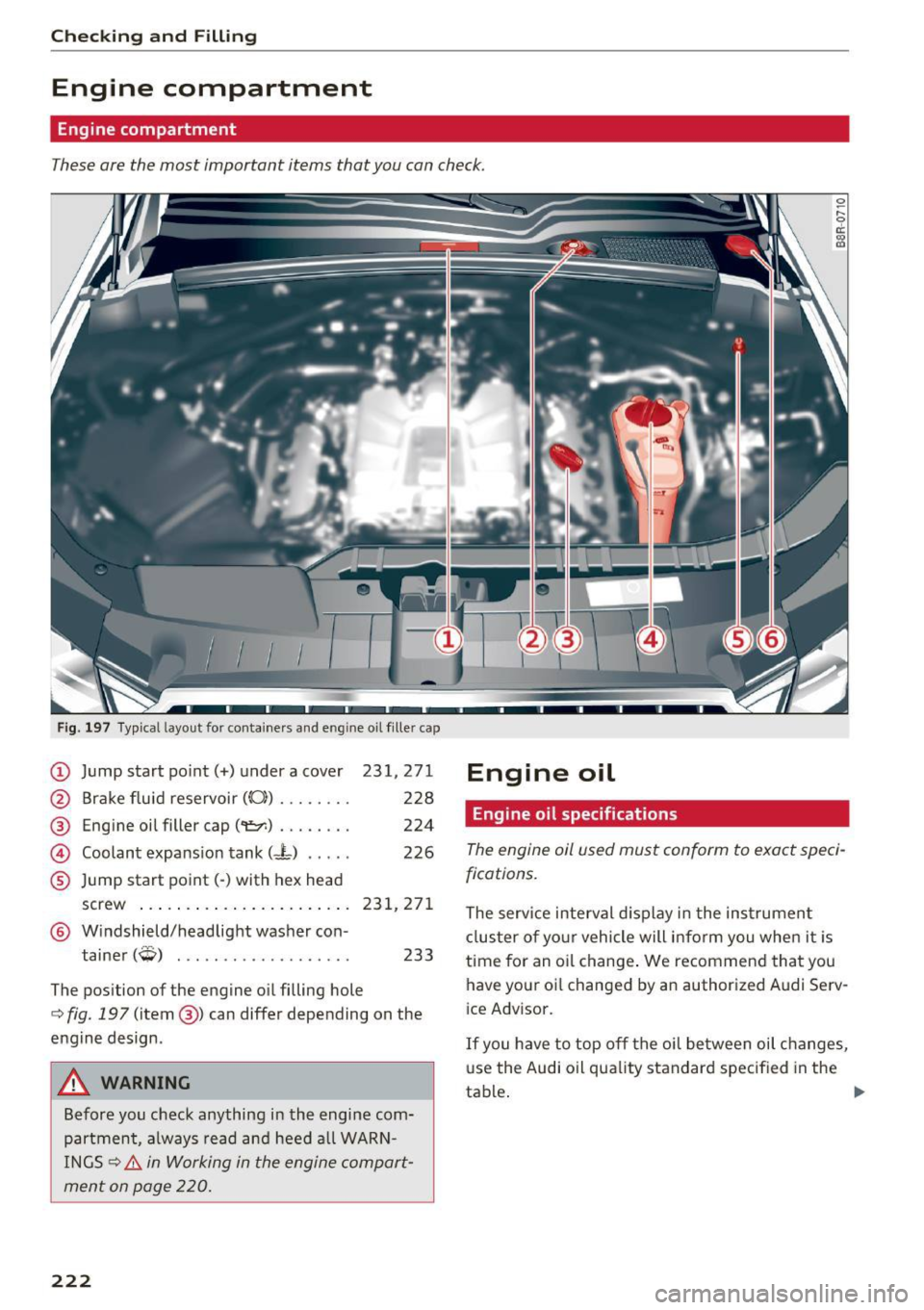
Checking and Filling
Engine compartment
Engine compartment
These are the most important items that you can check.
Fig. 197 Typical layout for con tainers and eng ine oil filler cap
® Eng ine oil filler cap ("1::7':) ........ 224
© Coolant expansion tank (- L) ..... 226
® Jump start point(-) with hex head
screw
. .. .. .... .............. 231,271
® Windshield/headlight washer con-
tainer
(Q) ................... 233
The position of the engine oil filling hole
¢ fig. 197 (item @) can differ depending on the
engine design .
A WARNING
Before you check anything in the engine com
partment, always read and heed all WARN
INGS ¢.&.
in Working in the engine compart
ment on page 220.
222
Engine oil
Engine oil specifications
~ r--0 d::
"' t0
The engine oil used must conform to exact speci
fications.
The serv ice interval display in the instrument
cluster of your vehicle will inform you when it is
time for an oi l chang e. We recommend that you
have your oi l changed by an authorized Audi Serv
i ce Advisor.
If you have to top off the oil between oil changes,
us e the Audi oil quality standard specified in the
ta ble.
~
Page 225 of 300
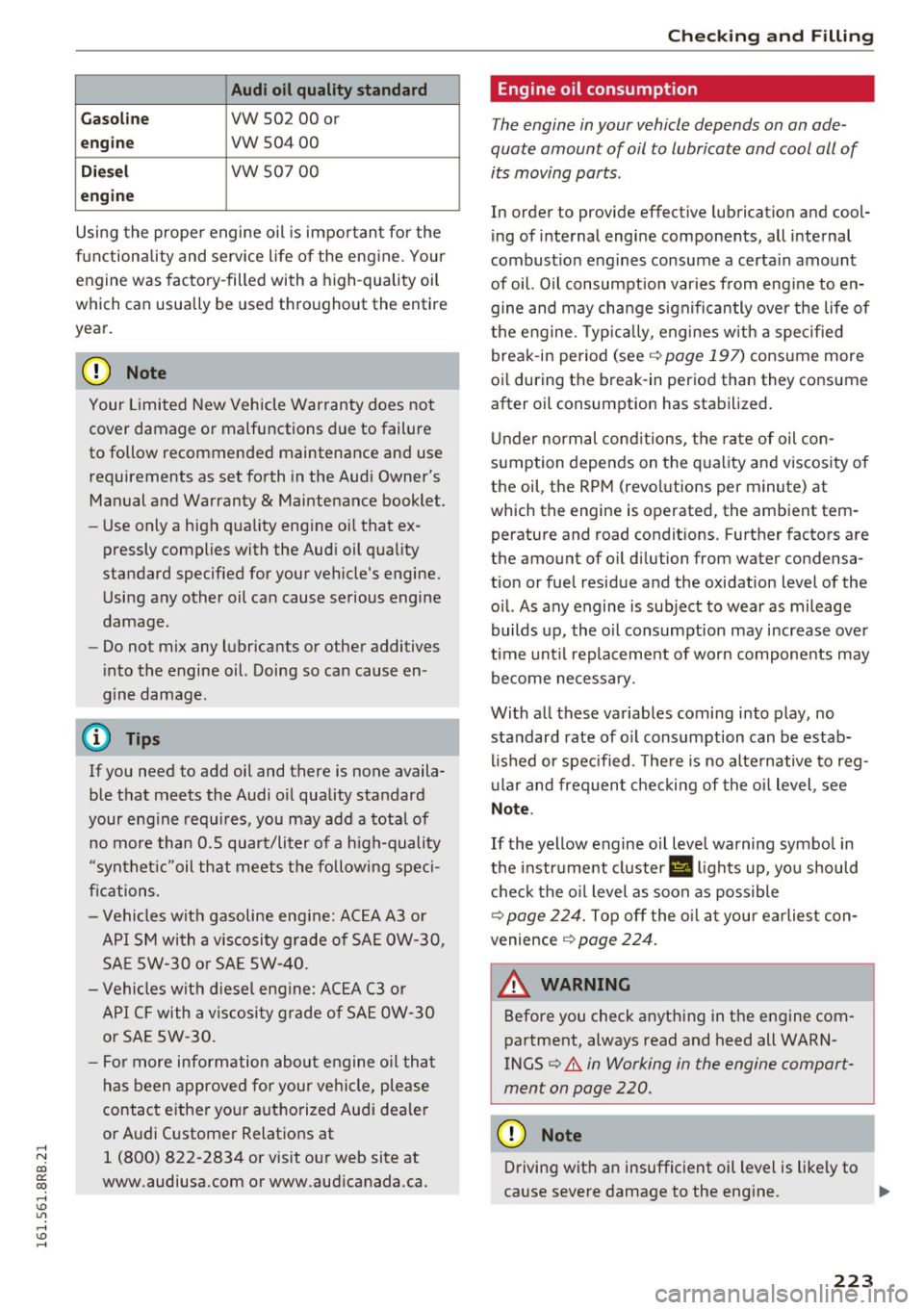
Audi oil quality standard
Gas oline
VW 502 00 or
engi ne vw 504 00
Die sel vw 507 00
en gin e
Using the prope r engine oil is important for the
functiona lity and service life of the eng ine. Your
engine was factory-filled with a high -quality oil
which can usually be used throughout the entire
year.
@ Note
Your Limited New Vehicle Warranty does not
cover damage or malfunctions due to failure
to follow recommended maintenance and use
requirements as set forth in the Audi Owner's Manual and Warranty
& Maintenance booklet.
- Use only a high quality eng ine oil that ex-
pressly complies with the Aud i oil quality
standard specified for your vehicle's engine.
Using any other oil can cause serious engine
damage .
- Do not mix any lubricants or other additives
into the engine oil. Doing so can cause en
gine damage.
(D Tips
If you need to add oil and there is none availa
ble that meets the Audi o il quality standard
your eng ine requ ires, you may add a total of
no more than 0.5 quart/liter of a h igh-quality
"synthet ic"oil that meets the followi ng speci
fications.
- Vehicles with gasoline eng ine: AC EA A3 o r
API SM wi th a viscosity g rade of SA E OW-30,
SAE SW-30 or SAE SW-40.
- Vehicles wit h diesel eng ine: ACEA C3 o r
API CF with a v iscosi ty grade of SA E OW-30
or SA E SW -30.
- Fo r more information abou t engine o il that
has been approved for your vehi cle, please
contact either you r a utho rized Audi dea ler
or A udi Customer Relations at
~ 1 (800) 822-2834 or visit our web site at co
g:; www.audiusa.com or www.aud icanada.ca.
Ch eck ing and Filling
Engine oil consumption
The engine in your vehicle depends on on ade
quate amount of oil to lubricate and cool oil of
its moving ports.
In order to provide effect ive lubrication and cool
i ng of internal engine components, all internal
combust ion eng ines consume a certa in amount
of oil. Oil consumption varies from eng ine to en
gine and may change s ign ificantly ove r the life of
the engine. Typ ica lly, engines w ith a specified
break-in period (see
¢ page 197) consume more
oi l during the break -in period than they consume
after oil consumption has stabilized.
Under normal cond itions, the rate of oil con
sumption depends on the q uality and viscosity o f
the oil, the RPM (revol utions per minute) at
which the engine is operated, the ambient tem
perature and road condit ions. Further factors are
the amount of oil dilution from water condensa
tion or fuel residue and the oxidation level of the o il. As any engine is subject to wear as mileage
builds up, the oil consumption may increase over
time unt il replacement of worn components may
become necessary.
With all these variables coming into play, no standard rate of o il consumption can be estab
li shed or spec ified . T he re is no alte rnative to reg
u la r and frequent checking of the oi l level , see
Note .
If the yellow engine o il leve l warning symbo l in
the instrument cluster
II lights up, yo u should
c h eck the o il level as soon as possible
¢ page 224. Top off the o il at your earlies t con
venience
¢ page 224.
A WARNING
--=-
Before you check anything in the engine com-
partment, always read and heed all WARN
INGS
¢ &. in Working in the engine comport
ment on page 220.
(D Note
Driving wit h an insufficient oil level is likely to
cause severe damage to the eng ine. ..,.
223
Page 226 of 300
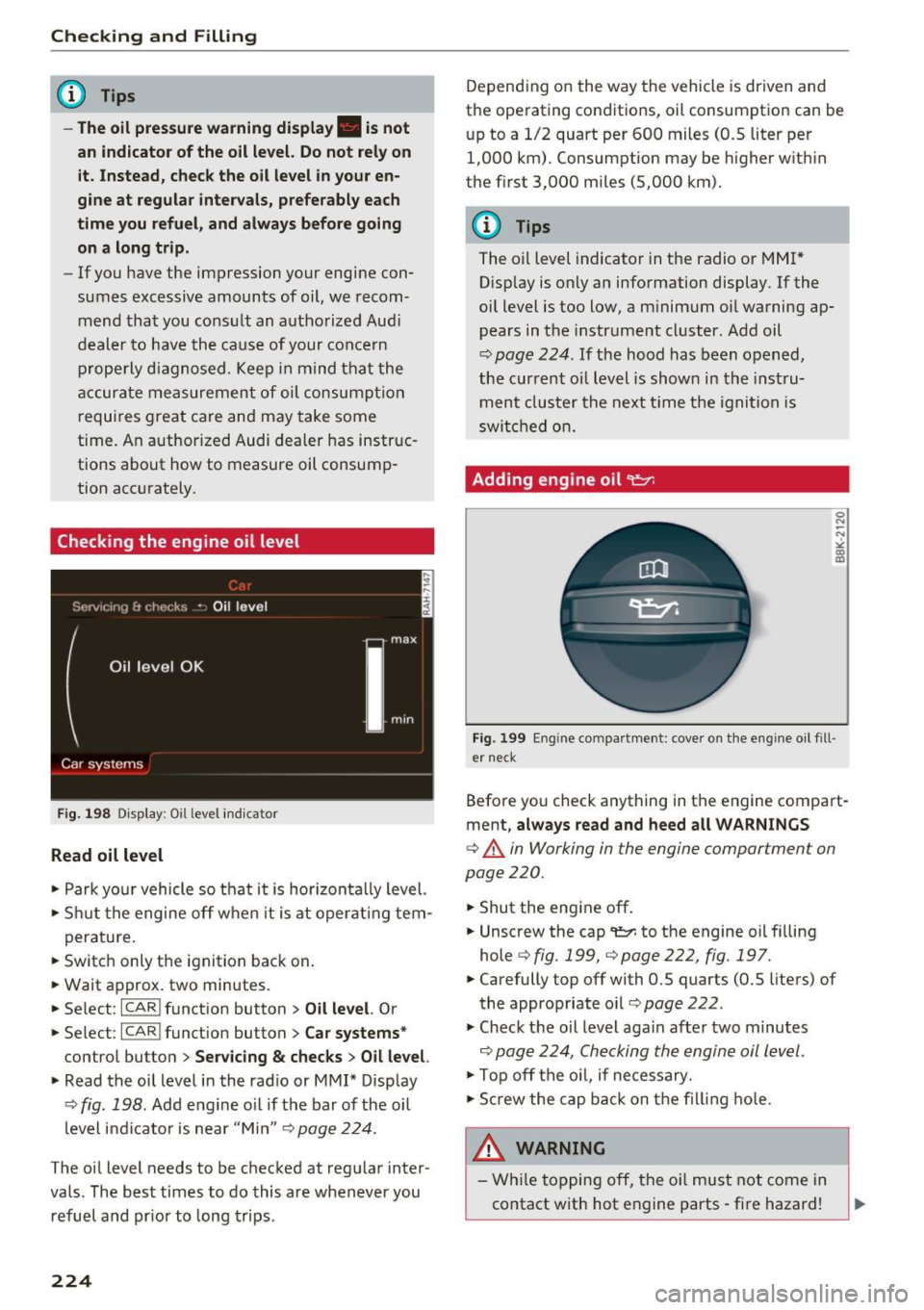
Checking and Filling
@ Tips
-The oil pressure warning display. is not
an indicator of the oil level. Do not rely on
i t. Instead , check the oil level in your en
gine at regular intervals, preferably each
time you refuel, and always before going
on a long trip.
- If you have the impression your engine con
sumes excessive amounts of oil, we recom
mend that you cons ult an autho rized Aud i
dealer to have the cause of your concern
properly diagnosed . Keep in mind that the
accurate measurement of oil consumption
requires great care and may take some
time. An authorized Audi dealer has instruc
tions about how to measure oil consump
tion accurately.
Checking the engine oil level
Fig. 198 D is play: Oil level indicator
Read oil level
• Park yo ur vehicle so that it is hor izonta lly level.
• Shut the engine off when it is at operating tem-
perature.
• Switch only the ignition back on.
• Wait approx . two minutes.
• Se lect:
ICARI function button > Oil level. Or
• Se lect:
ICARI funct ion button> Car systems *
control button > Servicing & checks > Oil level.
• Read the oil level in the radio or MMI* Display
¢
fig. 198. Add engine o il if the bar of the oil
level indicator is near "Min"
Q page 224.
The oil level needs to be checked at regular inter
vals. The best times to do this are whenever you refuel and pr ior to long trips .
224
Depending on the way the vehicle is driven and
the operating conditions, oil consumption can be
up to a 1/2 quart per 600 miles (0.5 liter per
1,000 km). Consumption may be higher w it hin
the first 3,000 miles (5,000 km).
(D Tips
The o il level indicator in the radio or MMI*
D isp lay is only an information display. If the
oil level is too low, a m inimum oil warning ap
pears in the instrument cluster. Add oil
¢
page 224. If the hood has been opened,
the current oil level is show n in the instru
ment cluster the next time the ignition is
switched on.
Adding engine oil
er neck
Before yo u check anything in the engine compart
ment,
always read and heed all WARNINGS
¢ .&. in Working in the engine compartment on
page 220.
• Shut the engine off.
• Unscrew the cap
't=r. to the engine oil f illing
hole ¢
fig. 199, ¢ page 222, fig. 197.
• Carefully top off with 0.5 quarts (0.5 liters) of
the appropriate oil¢
page 222.
• Check the oil level again after two minutes
Q page 224, Checking the engine oil level.
• Top off the oil, if necessary .
• Scr ew the cap back on the filling hole.
& WARNING
- While topping off, the oil must not come in
contact with hot engine parts - fire hazard!
Page 227 of 300
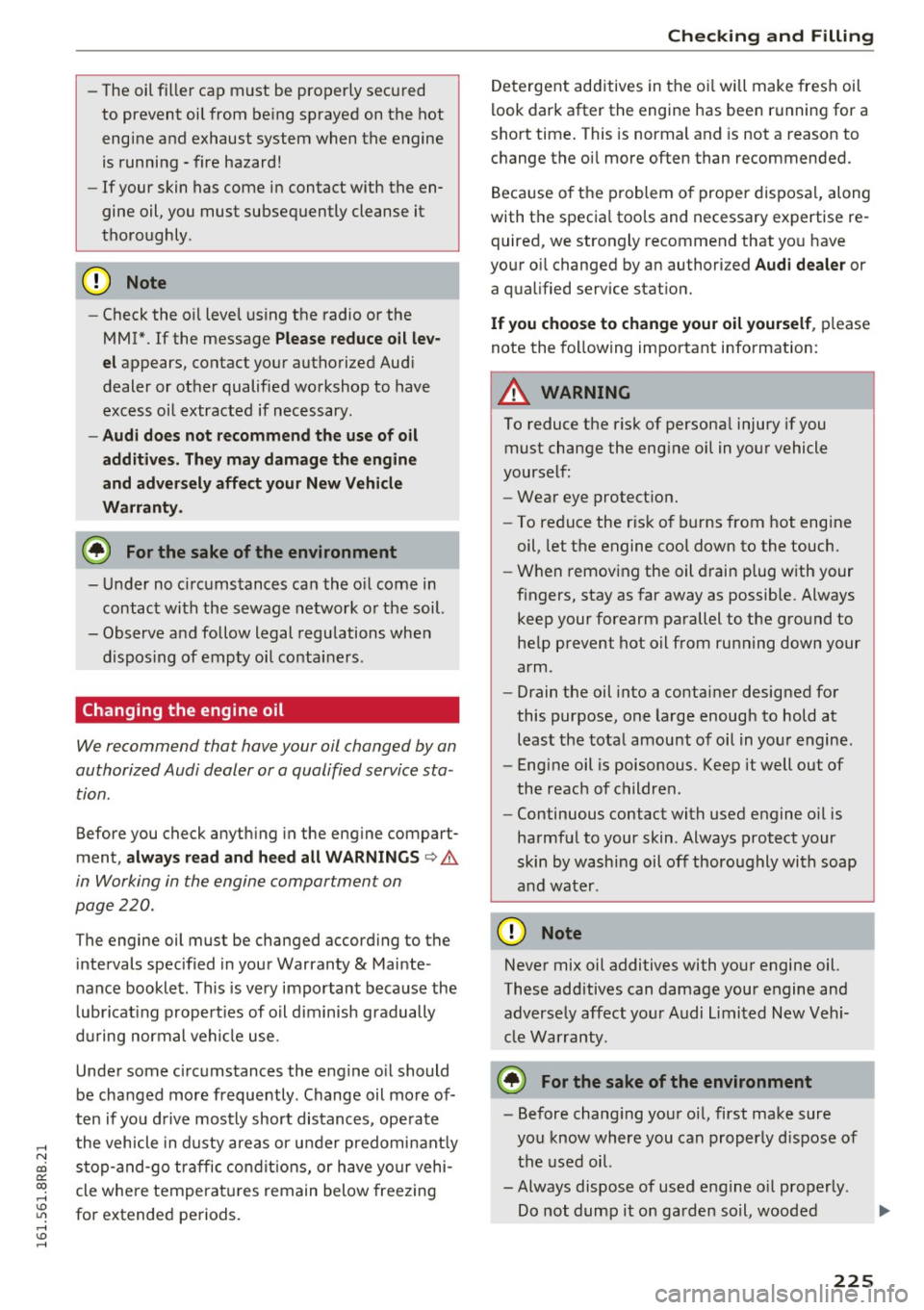
,....,
N
co
er::
co
,....,
to prevent oil from be ing sprayed on the hot
engine and exhaust system when the engine
is running -fire hazard!
- If your skin has come in contact with the en
gine oil, you must subsequently cleanse it
thoroughly .
@ Note
-Check the oil level using the radio or the
MM!*. If the message
Ple ase redu ce oil l ev
el
appears, contact your authorized Aud i
dealer or other qualified workshop to have
excess oil extracted if necessary.
- Audi do es not recommend th e use of o il
addit ive s. The y ma y damage the eng ine
and ad verse ly affect your New Vehicle
Wa rranty.
@ For the sake of the environment
- Under no circumstances can the o il come in
contact with the sewage network or the soil.
- Observe and follow legal regulations whe n
dispos ing of empty oil conta iners.
Changing the engine oil
We recommend that have your oil changed by an
authorized Audi dealer or a qualified service sta
tion.
Before you check anyth ing in the eng ine compart
ment,
alw ays read and h eed all WARNING S c:> .&.
in Working in the engine compartment on
page 220 .
The engine oil must be changed according to the
intervals specified in your Warranty
& Mainte
nance booklet . This is very important because the
l ubricat ing propert ies of o il d iminish gradually
du ring normal vehicle use.
Under some circumstances the engine o il should
be changed more frequently . Change oil more of
ten if you drive mostly short distances, operate
the veh icle in dusty areas or under predominant ly
stop-and -go traffic condit ions, or have yo ur vehi
cle whe re temperatures remain below freezing
for extended periods.
Ch eck ing and Filling
Detergent additives in the oi l will make fresh oil
look dark after the engine has been running for a
short time . This is normal and is not a reason to
change the oi l more often than recommended.
Because of the problem o f proper disposal, along
with the specia l tools and necessary expertise re
quired, we strongly recommend that yo u have
your o il changed by an authori zed
Audi dealer or
a qual ified service stat ion.
If y ou choo se to chan ge your oil your self , please
note the following important information:
A WARNING "--
To reduce the risk of persona l injury if you
must change the eng ine oil in your vehicle
yourself:
- Wear eye protection.
-
-To reduce the r isk of burns from hot engine
oil, let the engine cool down to the touch.
- When remov ing the oil drain plug w ith your
f ingers, stay as far away as possible. Always
keep your forearm parallel to the ground to
he lp prevent hot oil from running down your
arm.
- Drain the oil into a container designed for
this purpose, one large enough to hold at least the tota l amou nt of oil in your engine.
- Engine oil is poisonous. Keep it well out of
the reach of childre n.
- Continuous contact with used engine o il is
harmful to your skin. Always protect your
skin by washing oil off thoroughly with soap
and water .
«I) Note
Never mix oil additives with your engine oil.
These additives can damage your engine and
adverse ly affect yo ur Audi limited New Vehi
cle Warranty .
@ For the sake of the environment
-Before chang ing yo ur oi l, first make sure
you know where you can properly d ispose of
the used oil.
- Always dispose of used engine o il properly .
Do not dump it on ga rden soil, wooded
225
Page 228 of 300
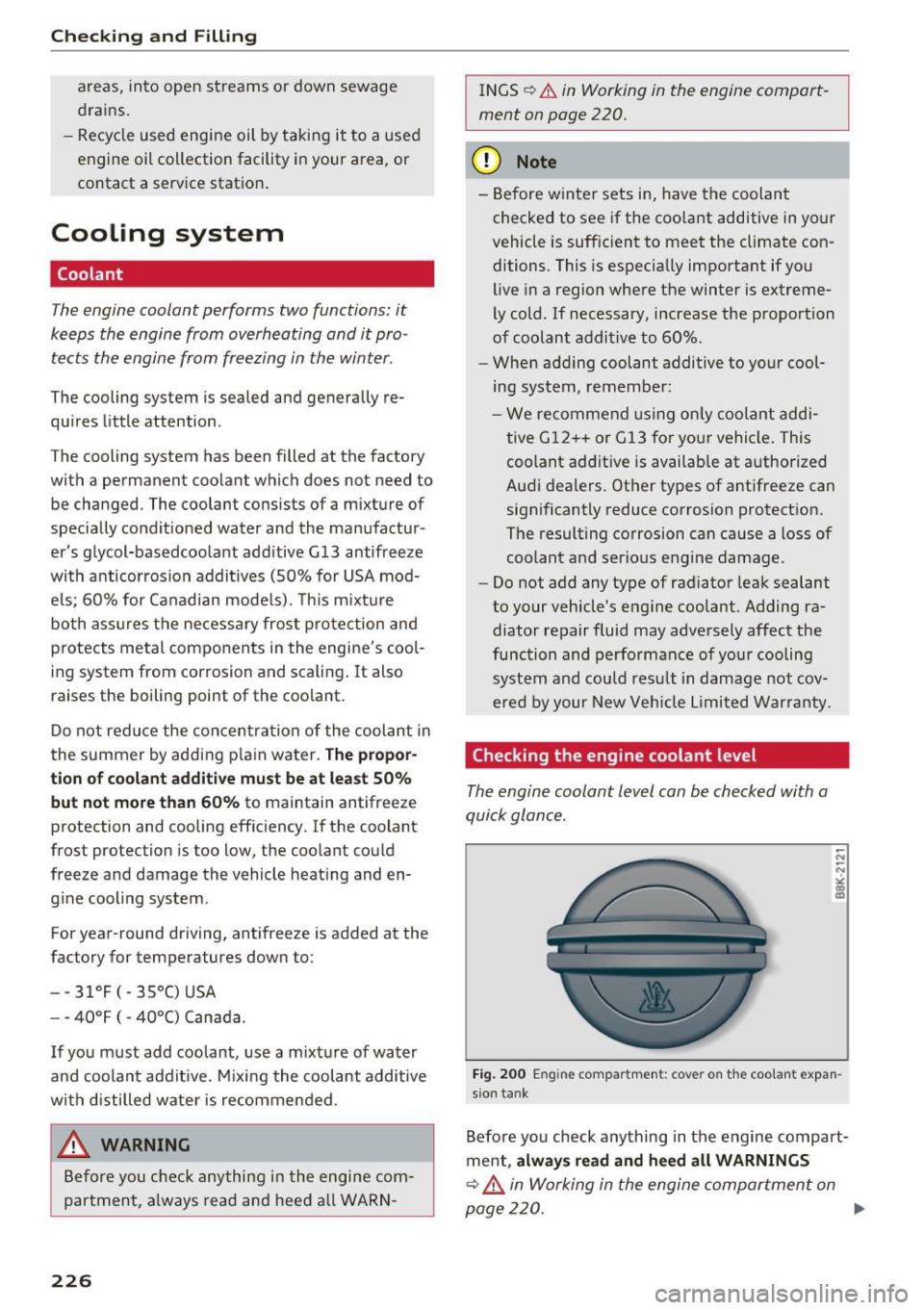
Checking and Filling
areas, into open streams or down sewage
drains.
- Recycle used engine oil by taking it to a used
engine oil collection facility in your area, or
contact a service station .
Cooling system
Coolant
The engine coolant performs two functions: it
keeps the engine from overheating and it pro tects the engine from freezing in the winter.
The cooling system is sealed and generally re
qu ires little attention .
The cooling system has been filled at the factory
with a permanent coolant which does not need to
be changed. The coolant consists of
a mixture of
specially conditioned water and the manufactur
er's g lycol-basedcoo lant additive G 13 antifreeze
w ith anticorrosion addi tives (50% for USA mod
e ls· 60% for Canadian mode ls). This m ix ture
'
both ass ures the ne cess ary fros t protection and
p rotects metal com ponents in the engi ne's coo l
ing system from corrosion and scaling .
It also
raises the boiling point of the coolant.
Do not red uce the concent ra tion of the cool ant in
the s ummer by addi ng p la in water.
The propor
tion of coolant additive must be at lea st 50 %
but not more than 60 %
to maintain antifreeze
protection and cooling efficiency. If the coolant
frost protection is too low, the coo lant could
freeze and damage the vehicle heat ing and en
g ine cooling system .
For year -round driving, antifreeze is added at the
factory for temperatures down to:
- -3 1 °F
c -3s0c) usA
- -4 0° F ( -40°C) Canad a.
I f you must add coolant, use a m ixt ure of wa ter
and coolant add it ive. M ixing the coolant additive
with d istilled water is recommen ded.
_& WARNING
B efore you che ck anyt hing i n the engine com
partmen t, a lways read and heed all WARN -
226
INGS ~ & in Working in the engine compart
ment on page 220.
(D Note
- Be fore w inter sets in, have the coolan t
checked to see if the coo lant additive in your
vehicle is suff ic ient to meet the climate con
ditions. This is especially important if you
live in a region where the winter is extreme
ly cold. If necessary, increase the proportion
of coolant addi tive to 60% .
- Whe n adding coolant additive to your cool
ing system, remember:
- We re commend usin g on ly coo lant addi
tive G12++ o r G13 fo r yo ur vehicle. This
coolant ad dit ive is availab le at authorized
Audi dealers. Other types of antifreeze can
significantly reduce corrosion protection.
The resulting corrosion can cause a loss of
coolant and serio us engine damage.
- Do not add any type of radiato r leak sealant
to your vehicle's engine coolant. Adding ra
diator repair fluid may adversely affect the
function and perfo rmance of yo ur cooling
system and cou ld resu lt in damage not cov
ered by your New Ve hicle Li mited War ranty.
Checking the engine coolant level
The engine coolant level can be checked with a
quick glance.
Fi g. 20 0 Eng ine compartment: cover on the coo lant expan
s io n tank
Befo re yo u check anything in the engine compart
ment,
always read and heed all WARNINGS
~ ,& in Working in the engine compart,nen t on
page 220. ..,.
Page 229 of 300
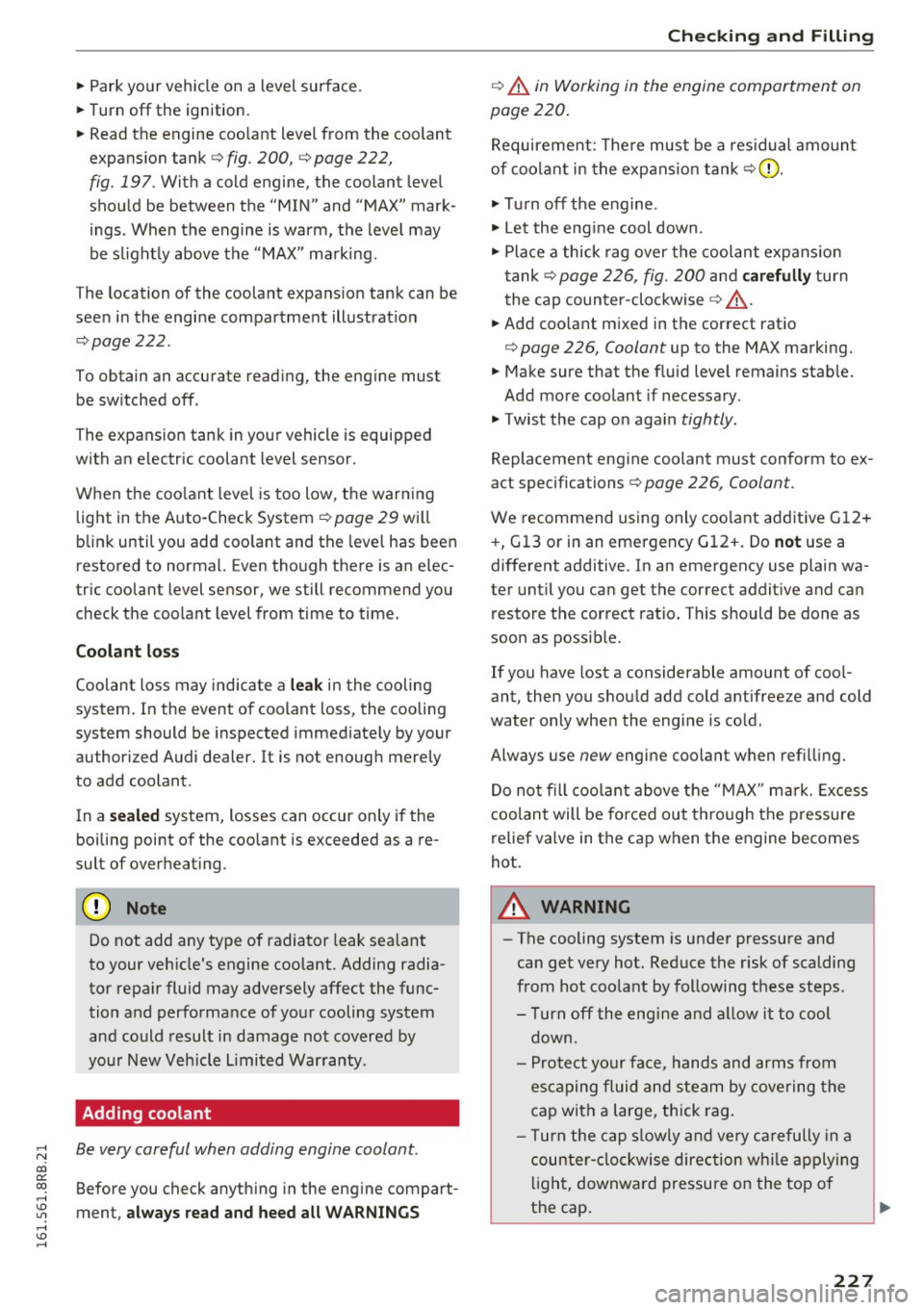
.... N
co
er::
co
....
.,. Turn
off the ignition.
.,. Read the engine coolant level from the coolant
expansion tank
c> fig . 200, c> page 222,
fig. 197. With a cold engine, the coolant level
should be between the "MIN" and "MAX" mark
i ngs . When the engine is warm, the level may
be s light ly above the
"MAX " marking .
T he location of the coolant expans ion tank can be
seen in the engine compartment illustrat ion
i=> page 222.
To obtain an accurate reading, the engine must
be sw itched
off.
The expansion tank in your vehicle is equipped
with an electric coolant level sensor.
When the coo lant level is too low, the warning
light in the Auto-Check System
c:> page 29 wi ll
blink until you add coolant and the level has been
restored to normal. Even though there is an e lec
tr ic coolant level sensor, we still recommend you
check the coolant level from time to time.
Coolant loss
Coolant loss may indicate a leak in the cooling
syst em. In the event of coolant loss, the cooling
system should be inspected immediately by your
authorized Audi dealer. It is not enough merely
to add coolant .
In a
sealed system, losses can occur only if the
boiling point of the coo lant is exceeded as a re
sult of overheat ing .
(D Note
Do not add any type of radiator leak sealant
to your veh icle's engine coolant. Adding radia
tor repair fluid may adversely affect the func
tion and performance of your cooling system
and could result in damage not covered by
your New Vehicle Limited Warranty .
Adding coolant
Be very careful when adding engine coolant.
Before you check anyth ing in the eng ine compart
ment,
always read and heed all WARNINGS
Checking and Filling
c> .&. in Working in the engine compartment on
page
220 .
Requirement: The re must be a residual amount
of coolant in the expans io n tank
c>@.
.,. Turn off the engine .
.,. Let the engine cool down.
.,. Place a thick rag over the coolant expansion
ta nk
c:> page 226 , fig. 200 and carefully turn
the cap counter-clockwise
c> _&. .
.,. Add coo lant mixed in the correct ratio
c:> page 226, Coolant up to the MAX marking .
.,. Make sure that the f luid level remains stable.
Add more coolan t if necessary .
.,. Twist the cap o n again
tightly.
Replacement engine coolant must conform to ex
act specifications
c:> page 226, Coolan t.
We recommend using only coolant addit ive Gl2 +
+ , Gl3
or in an emergency Gl2+. Do not use a
different additive . In an emergency use plain wa
ter until you can get the correct addit ive and can
restore the correct ratio. This should be done as
soon as possible.
If you have lost a considerable amount of coo l
ant, then you shou ld add cold antifreeze and cold
water only whe n the engine is cold.
Always use
new e ngine coolant when refilling.
Do not fill coolant above the "MAX " mark. Excess
coolant will be forced out through the pressure
relief valve in the cap when the engine becomes
hot.
A WARNING
-- The cooling system is under pressure and
can get very hot. Reduce the risk of scalding
from hot coolant by following these steps .
- Turn
off the eng ine an d allow it to cool
down.
- Protect your face, hands and arms from
escaping fluid and steam by covering the
cap with a large, thick rag.
- Tu rn the cap slowly and very carefully in a
counter-clockwise direction whil e applying
light, downward pressure on the top o f
the cap .
~
227
Page 230 of 300
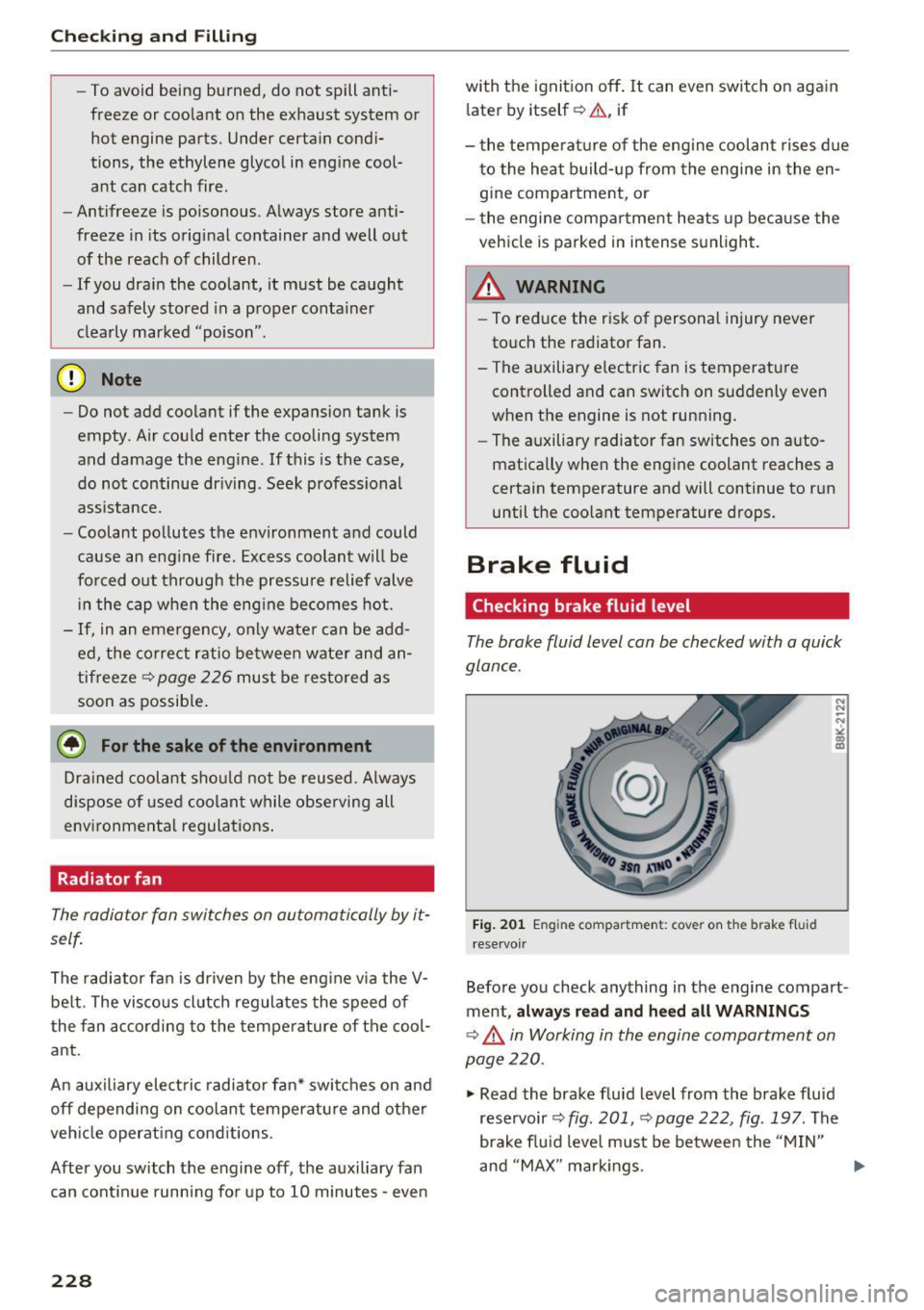
Checking and Filling
-To avoid bein g burned, do not spill anti
f reeze or coolant on the exhaust system or
hot engine parts. Under certain condi
tions, the ethylene glycol in engine cool ant can catch fire.
- Antifreeze is poisonous . Always store anti
freeze in its original container and well out
of the reach of children .
- If you dra in the coolant, it must be ca ught
and safely stored in a proper conta iner
clearly marked "poison".
(D Note
- Do not add coolant if the expansion tank is
empty . Air cou ld enter the cooling system
and damage the eng ine .
If this is the case,
do not continue dr iving . Seek professional
ass istance.
- Coolant pollutes the e nvironment a nd could
cause an eng ine fire. Excess coolant will be
fo rced o ut through the pressu re relief valve
i n the cap when the eng ine be comes hot .
- If, in an emergency, o nly wate r can be add
ed, the co rrect ratio between water and an
tifree ze ~
page 226 mus t be resto red as
soon as possib le .
@) For the sake of the environment
Drained cool ant sho uld not be reused. Always
dispose of used coo lant w hile obse rving all
environmenta l regulatio ns.
Radiator fan
The radiator fan switches on automatically by it
self.
The radiator fan is dr iven by the eng ine v ia the V
be lt . The visco us cl utch regula tes the speed of
the fan acco rding to the tempera ture of t he cool
ant.
An aux iliary ele ct ric radiator fan* swit ches on and
off depending on coolant tempera tu re and o ther
ve hicl e operat ing cond itions .
After you switch the engine off , the auxiliary fan
can cont inue runn ing fo r up to 10 minutes - even
228
with the ignition off . It can even switch o n aga in
l ater by itself~.&. , if
- the tempera ture of the engine coolant rises d ue
to the hea t build- up from the engine in the en
gine compartment, or
- the engine compa rtme nt heats up bec ause the
veh icle is parked in intense s unlight.
A WARNING
- To reduce the r isk of personal injury never
touch the radiator fan.
- The a uxiliary e lectric fan is temperat ure
controlled and can switch on suddenly even
when the engine is not runn ing .
-
-The a uxiliary radiator fan switches on a uto
mat ically when the eng ine coolant reaches a
certain temperature and will continue to r un
until the coo lant temperature drops.
Brake fluid
Checking brake fluid level
The broke fluid level con be checked with o quick
glance .
Fig. 20 1 En g in e com par tmen t: cov er on t he br ak e fluid
r e servo ir
N
N
-N
"' CIO a,
Befo re you check anything in the engine compart
ment,
always read and heed all WARNINGS
~ .&, in Working in the engine comportment on
page 220 .
.,. Read the brake fluid level from the bra ke f luid
rese rvoir ~
fig. 201, <> page 222, fig . 197. The
brake fl uid leve l must be between the "M IN"
and "MAX " mark ings .